#straw harvest add on
Explore tagged Tumblr posts
Text
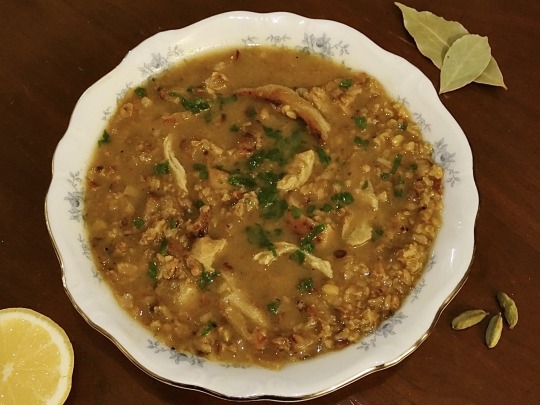

[ID: A greenish-brown soup with an herb garnish in a bowl surrounded by a halved lemon, green cardamom pods, and bay leaves, followed by a close-up of the same soup. End ID]
شوربة الفريكة / Shorabat al-frika (Green wheat soup)
Frika (فَرِيكَة or فَرِيك; also transliterated "freekeh," "frikeh," or "farik") is durum wheat harvested in the early spring, while the grain is green, unripe, and tender. Durum wheat, or semolina, is a different species of wheat than that which is ground to produce all-purpose flour (common wheat, or bread wheat); it is used to make couscous (كُسْكُس), bulghur (بلغور), and many types of pasta, and is widely consumed in North Africa, the Levant, and the Arabian peninsula. After harvest, unripe durum is sun-dried and then set ablaze in piles to burn off the straw and leave just the heads of wheat, resulting in a nutty, smoky flavor; the heads are then vigorously rubbed, traditionally by hand, to remove the bran. Frika is named after this last process; the word comes from the verb "فَرَكَ" "faraka," "to rub."
A staple in Palestine, shorabat al-frika (with diacritics, Levantine pronunciation: شُورَبَة الفْرِيكَة) is often eaten as an appetizer with the fast-breaking meal during Ramadan. It may contain nothing more than an onion, olive oil, frika, and water, but sometimes contains meat (usually chicken, but also beef or lamb), green chili peppers, and spices including cardamom, black pepper, bay leaves, turmeric, cumin, and seb'a baharat; some people today like to add chickpeas. Shorabat al-frika is often prepared with the chicken broth obtained by boiling chicken to make musakhkhan (مُسَخَّن), and served alongside it. It is a warming, filling, and earthy soup, with a complexity of flavor imparted by the frika itself: a fresh tartness due to the unripe grain, and a roasted aroma due to its harvesting process.
Shorabat al-frika is in keeping with a Palestinian food ethos of using simple, local ingredients to their fullest potential. Frika itself is sometimes thought to symbolize adaptability and resilience, as it was often eaten in times of scarcity when other crops were not yet ready to be harvested. Legend holds that it was discovered in a time of similar necessity: when villagers in the eastern Mediterannean tried to salvage a field of wheat that had been burned by ambushing soldiers, they found that the grain was still edible beneath the blackened chaff, having been saved from the fire by its moisture.
Frika, due to its centuries as a staple in Palestine, has also come to symbolize acceptance, Palestinian history, and connection to the land and community. In the Palestinian diaspora and amongst internally displaced people in Palestine, food is conceived of as a form of connection to homeland across distance; continuing to make Palestinian food, and remembering or using baladi ("native," "from my country") varieties of grains, produce, and herbs, is a link to the land and an expression of the hope to return.
By the same token, though, frika has come to represent Palestinian displacement and "cultural obliteration," per Rana Abdulla. One of the ways in which Israel rhetorically justifies its existence is by claiming sole ownership of an old, organically arising culture rooted in the land: the easiest way to do this is, of course, to rebrand what was already there. Food connects and combines language (in terminology and pronunciation), culture, history, climate, and land into one web of discourses, and is therefore a prime site for colonial myth-making and ideological nation-building. Thus a construction such as "Israeli freekeh" is, in fact, an intensely political one.
Nevertheless, frika continues its life as a symbol of connection, community, and resistance during adversity in Palestine. Nasser Abufarha, of the Palestine Fair Trade Association, noted in 2015 that more and more Palestinians across the West Bank were harvesting some of their wheat early to make frika, rather than relying on cheaper, imported rice. As of October 23 2023, and in defiance of an Israeli air raid which destroyed their kitchen in 2014, Jamil Abu Assi and his cousins were using frika, alongside lentils and rice, as staples in distributing food to thousands of refugees per day in Bani Suhaila, near Khan Younis. Others in the community donated ingredients or volunteered to distribute meals.
Support Palestinian resistance by contributing to Palestine Action's bail fund or to Palestine Legal's defence fund, or by attending court or making a sign to support the Elbit Eight.
Ingredients:
1 cup (170g) frika baladia (فريكة بلدية), Levantine frika
4 cups water, or vegetarian chicken stock from concentrate
1 large yellow onion, chopped
1/4 cup extra virgin olive oil
1 green chili pepper (فلفل أخضر حار), sliced (optional)
1/2 tsp ground black pepper (فلفل اسود)
5 cardamom pods (حب هال)
2 Mediterannean bay leaves (ورق غار)
250g chicken (or beef) substitute, torn or cubed (optional)
Salt, to taste
Parsley, to garnish
Halved lemon, to serve (optional)
I have kept the spices relatively simple, as most cooks do, to highlight the earthy end of the taste spectrum and to allow the flavor of the frika itself to come forward. Most people add at least cardamom and black pepper; many add bay leaves to this duo; turmeric is the next most common addition I have come across. I have seen a few people add cumin, coriander, or allspice.
Frika can be found in the grains section of your local halal grocery store (labelled "فريكة", “فريك" "freekeh" or "frikeh"). Look for something that specifies “roasted.”
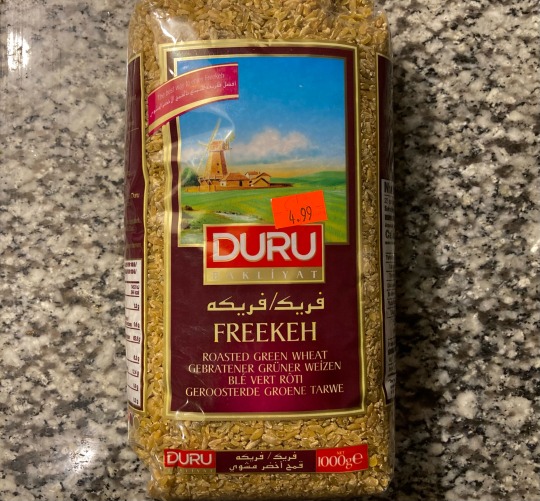
You may also be able to find frika at a speciality or health foods grocery store, but it might not have been fire-roasted as it is in the Levant. If your frika doesn't smell toasty, try roasting it in a dry pan on medium-heat for a few minutes until fragrant.
Frika may be found whole, cracked, or fine (نَاعِمَة / na'ima). You may use any kind for this soup; most people use cracked or fine frika, because of its shorter cooking time. You can pulse whole frika a few times in a food processor or spice mill, until coarsely ground, if you prefer a fine texture but can't find fine frika.
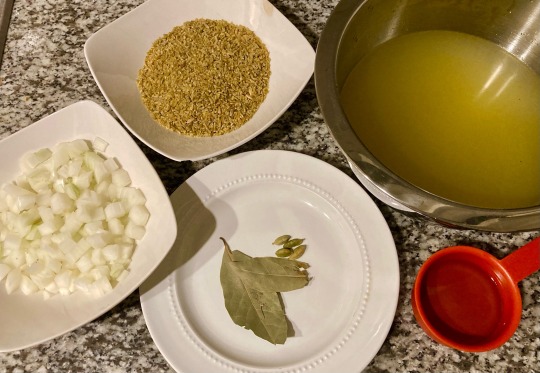
Instructions:
1. Heat olive oil in a large pot on medium. Add onion, a pinch of salt, cardamom pods, and bay leaves and fry, stirring occasionally, until the onion is golden brown.
2. Add the chili pepper and cook briefly until softened.
3. Add frika and black pepper and roast, stirring occasionally, for a few minutes until fragrant.
4. Add the water or stock and stir to combine. Bring to a fast simmer and cook, covered, about 50 minutes for whole frika and 20 minutes for ground, until fully cooked. Add additional water as necessary. The frika will still be chewy at the end of the cooking time.
5. Fry meat substitute of your choice in olive oil with salt, black pepper, and a optionally a pinch of Palestinian seven-spice, until browned. Add to soup and stir to combine. Taste the soup and add salt and more black pepper, if necessary.
6. Garnish with whole or chopped parsley and serve warm.
The meat is usually added to this soup just after the onions, and simmered along with the frika. You can do it this way if you like, but I have never found simmering to do the texture of meat substitutes any favors.
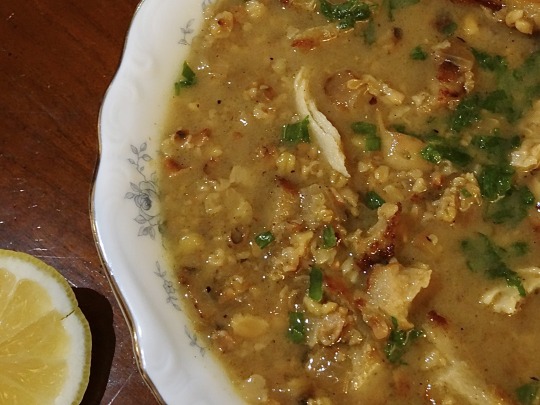
496 notes
·
View notes
Text
WAYS TO CELEBRATE THE SABBATS
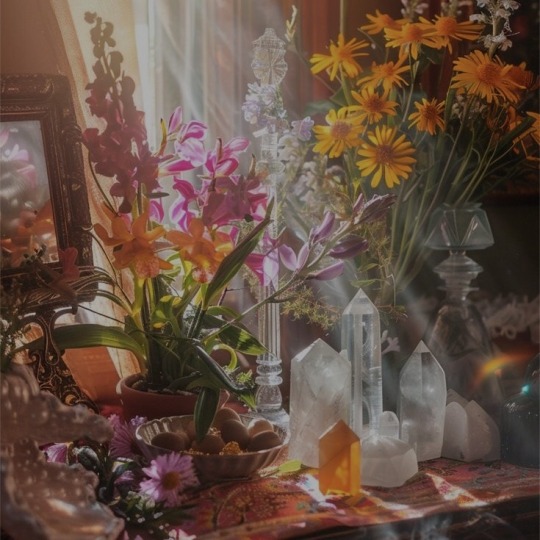
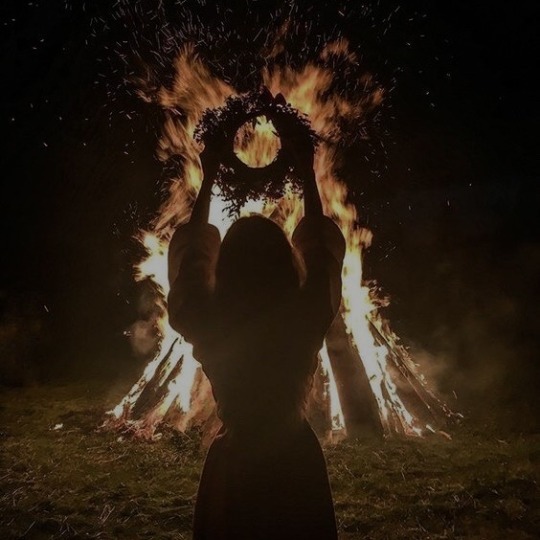
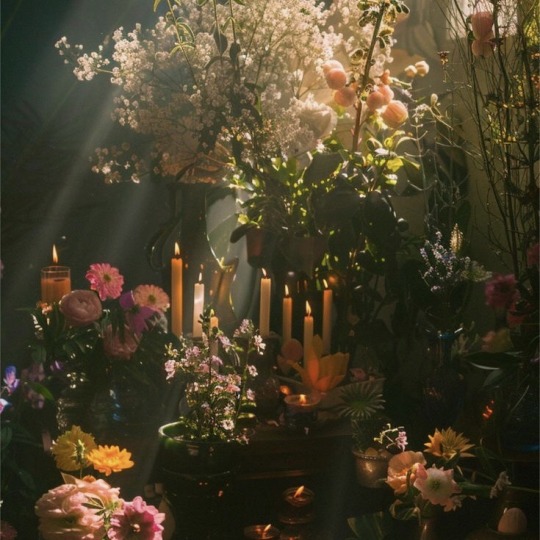
IMBOLC (CANDLEMAS)
Clean your home and space to welcome the coming of spring.
Bake a traditional Imbolc loaf of bread or other seasonal foods.
Use the colours white and yellow in your decorations and outfits.
Light a bonfire or light candles to represent the returning light.
Plant seeds or bulbs to symbolize the rebirth of nature.
Perform a ritual to honour the coming of spring and ask for protection and blessings.
Make a Brigid's cross or other handcrafted decorations with herbs and other natural materials.
Perform a blessing of your home and surroundings with holy water or smoke cleansing.
Set up an altar or sacred space to honour the Celtic goddess Brigid, associated with Imbolc.
Make Brigid's bed, a traditional ritual of placing straw under your bed to bring fertility and growth into your life.
Connect with nature and spend time outside to honour the changing season.
OSTARA (SPRING EQUINOX)
Participate in fertility rites and rituals to celebrate the coming of spring and the planting season.
Decorate your altar or sacred space with symbols of Ostara, such as eggs, bunnies, daffodils, and pastel colours.
Perform a spring cleaning of your home and life, releasing old habits and welcoming new beginnings.
Light a fire or light candles to honour the return of lighter, longer days.
Bake a traditional honey cake or other seasonal sweets to celebrate the sweetness of spring.
Plant seeds or herbs for new growth and prosperity.
Go for a nature walk or hike to connect with the natural world.
Participate in an egg hunt or egg rolling, traditional Ostara games
Perform a protection spell or ritual to honour the increasing light and longer days.
Practice self-care rituals to nourish and rejuvenate your mind and body.
BELTANE (MAY EVE)
Celebrate the fertility of the earth with bonfires and rituals honouring the fire god, Belenos.
Make a maypole and decorate it with colourful ribbons.
Participate in a maypole dance, a traditional celebration of fertility and joy.
Make a wish list and tie it to a tree on Beltane eve.
Collect flowers, especially May blossom or hawthorne flowers, and make a garland or crown to wear.
Create a flower crown or wear one made of wildflowers to honour the faery folk and fertility spirits.
Perform a ritual to bless your home and land for prosperity and protection.
Jump over the Beltane bonfires, symbolizing jumping over obstacles and embracing new beginnings.
Have a picnic or gathering with friends and family to celebrate the abundance and growth of the season.
Create a sacred space or altar for Beltane, decorat with flowers, herbs, and other nature-related objects.
Perform a cleansing ritual to rid yourself of negative energy and welcome the energy of new beginnings.
Make a bouquet of wildflowers or herbs, and hang it on your front door to welcome the spirits of Beltane.
Go for a walk in the woods or a natural setting and connect with the beauty and energy of the season.
LITHA (SUMMER SOLSTICE/MIDSUMMER)
Participate in a bonfires or lighting a sacred fire, celebrating the arrival of the longest day of the year.
Collect herbs and flowers, especially ones associated with the sun, such as calendula, yarrow, and St. John's wort, and make a solstice garland.
Perform a ritual to honour the sun and ask for protection and blessings.
Dance around the bonfire or engage in other traditions associated with the Summer Solstice, such as singing and drumming.
Have a solstice feast, filled with summer bounty, seasonal foods, and family.
Celebrate in the natural world, go for a walk, or have a picnic during the longest day.
Honour the Celtic goddess Litha, associated with the Summer Solstice.
Start summer resolutions.
Get your hands dirty and embrace the earth. Consider planting a vegetable garden for fall harvest or add to your flower garden to mark the occasion.
LAMMAS (LUGHNASADH)
Baking bread.
Crafting corn dolls.
Pick wild flowers.
Honour the earth and the cycles of nature.
Perform Sun magick.
Give thanks to the spirits and/or deities for the beginning of the harvest season.
Collect and honour the first fruits of the harvest, such as grains, corn, and apples.
Perform a ritual to honour Lugh and thank the gods and goddesses for the harvest.
Hold a harvest festival or feast, sharing the bounty of the land with family and friends.
Make a Lughnasadh altar or shrine with symbols of the harvest, such as corn, grains, and apples.
Participate in a traditional Lughnasadh celebration, such as a harvest dance or ritual.
Collect herbs and plants for healing and protection, as Lughnasadh is traditionally a time for preparing for the winter months.
MABON (AUTUMN EQUINOX/FALL HARVEST)
Celebrate the balance between light and dark, and the onset of the harvest season.
Honour the Celtic god Mabon, associated with the Autumn Equinox.
Participate in a harvest celebration, collecting and honouring the fruits of the land.
Make a corn dolly or a straw figure as a reminder of the abundance of the harvest.
Perform a ritual to honour the balance of the seasons and thank the gods and goddesses for their blessings.
Spend time writing in your journal. You could reminisce about your summer experiences, reflect on the shifts you feel with the changing season, contemplate what you're ready to release, or express gratitude for the blessings in your life.
Participate in a nature walk or ceremony, taking time to connect with the natural world and the turning of the seasons.
Enjoy your favourite fall beverages.
Make a gratitude list or write a gratitude letter, expressing your appreciation for the abundance and beauty of the harvest season.
Connect with nature.
Bring the beauty of fall indoors by decorating your home with seasonal touches.
Performing a gratitude or release ritual.
SAMHAIN (ALL HALLOWS/FINAL HARVEST)
Carving pumpkins with friends.
Relax and watch some horror movies.
Treat yourself to sweets.
Participate in a haunted house, hayride, or corn maze event.
Declutter/organize your home.
Focus on letting go to make space for the new year.
Collecting leaves.
Bake treats that contain pumpkin.
Creating a spooky, atmospheric decor for your home or workspace, such as cobwebs, faux spiders, and other creepy décor items.
Gathering friends and loved ones for a Samhain feast, feasting on symbolic foods like apples, pumpkin, or corn.
Visit a local pumpkin patch.
Making personalized altar items and decorative pieces for your sacred space, such as witch jars, mandalas, sigils, symbols of the harvest, items associated with death, etc.
Participating in a divination practice like tarot reading, scrying, or rune casting to gain insight and connect with the energy of the night.
Go to a harvest festival or carnival.
Hold a Samhain seance or mediumship session to contact the spirits of loved ones who have passed on.
Participate in a potluck dinner with witches and pagans, dressing in traditional Samhain garb.
RESPECTFULLY visit a graveyard.
YULE (WINTER SOLSTICE/MIDWINTER)
Burn a Yule log.
Make an evergreen Yule wreath.
Decorate a Yule tree.
Make a Yule wish list or a Yule resolution, as Yule is a time of reflection and intention setting.
Practice Yule carol singing, participating in a community sing-along or carolling event.
Celebrate in candle light.
Give back to nature.
Exchange nature-based gifts.
Host a feast for those you love with foods associated with Yule, such as: roast goose, Yule ham, nuts, berries, spices, squash, and potatoes.
Eat or make/bake Yule ham, gingerbread, mulled wine, roast goose, spiced cakes, shortbread, snowball, caraway, ginger snaps, honey cakes or pastries, and biscuits.
Eat or give sweets flavoured with nutmeg, cinnamon, ginger, or peppermint.
Participate in the longest night of the year and prepare for the return of the light.
Honour deities associated with Yule, such as Odin, Baldur, Hel, Loki, Sol, Freyr, Njörðr with lights, candles, and bonfires.
Participate in a Yule spell or ritual, asking for blessings and protection for the coming year.
Decorate your home with evergreen boughs and wreaths, representing the evergreen nature of the sun and eternal life.
Host a Yule log ceremony.
Participate in an outdoor activity, like sledding or ice skating, to honour the winter season.
#fyp#fypシ#fypシ゚viral#fypage#fyppage#tumblr fyp#witchcraft#witches#witch#witchcore#witchblr#witch community#sabbats#imbolc#ostara#spring equinox#beltane#midsummer#litha#lughnasadh#lammas#autumn equinox#mabon#fall harvest#samhain#all hallows eve#yule#winter solstice#information#wheel of the year
66 notes
·
View notes
Text
Day 28: pumpkin patch
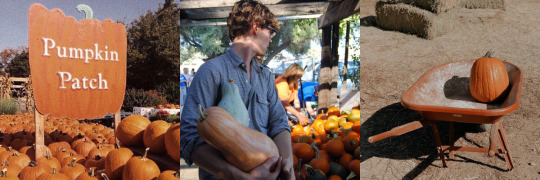
Masterlist flufftober 🎀
Reblog if you liked it!
“Remember that to choose the ideal pumpkin we have to check that it doesn’t have bruises or soft parts and is decomposing, this will make the carving much easier and the final product will last longer”
“Don't worry, pretty, I'll be sure to check with you first,” you murmured, trying not to sound too amused at your boyfriend's excitement.
Autumn had already fallen and with it the pumpkin harvests also appeared, whether to prepare pie, soup, or carve a beautiful design to decorate. Your boyfriend had insisted that you accompany him to one of the first activities in a long schedule of Halloween preparations, and since your porch had enough space to put up decorations, you would take an afternoon to carve some pumpkins.
You were holding his hand when you walked towards the entrance of the pumpkin patch, where there were already some people and families choosing the best specimens on the piles of straw or placed in huge wooden boxes. The field was huge so the two of you would be busy enough walking around it for a while; not that you were complaining though, you loved spending time with him.
"Are you cold?" he asked, once you stopped at the first pile of pumpkins, while he adjusted the scarf you were wearing. Although the day was sunny you had to admit that the air was cool and you were grateful to him for insisting you wear something warm.
Spencer, for his part, had decided to wear brown pants, boots, and a blue plaid shirt that was very messy; open collar, untucked, and with the sleeve folded three-quarters over his muscular arms. However, that wasn't what had you enthralled, but the black-rimmed glasses on his face. The doctor had recommended using them again for a few weeks so that his eyes could rest, and of course you hadn't made a single complaint about that.
“No, everything is perfect,” you smiled, stretching out so you could press a kiss to his cheek and watching him form a smile of your own “These pumpkins here are cute, do you want to see them?”
Your boyfriend was an expert in many things and choosing those kinds of vegetables seemed to be another one to add to the list. There were various colors, some paler than others, some in shades of green, and others completely bright orange; small, large, elongated, all with curious and varied shapes.
You kept walking next to him, exchanging a few words from time to time, while he felt the specimens in front of you. At some point you got distracted by something else and when you looked back you found him in a position that made you sigh. His body was facing you, but his head was focused on something else, as if he were debating with himself whether to carry a third pumpkin, allowing you a view of the length of his neck and the profile of his face. There were soft rays of sunlight bathing his hair and skin, giving it a golden glow that contrasted with the coldness of the time, and you simply couldn't miss the opportunity to capture the moment.
Spencer turned at the sound of your phone's camera and smiled shyly when he realized you had just taken a photo of him.
"What are you doing?"
“You looked very handsome,” you laughed, proudly showing him the image on your cell phone screen.
"You think?"
“Of course, you are my ray of sunshine,” you called him affectionately, stretching out a hand to caress his face that had already completely blushed.
“Do you like these? I thought we could make soup with them.”
“They look good”
“Do you want me to pick one for you to carve?” he asked excitedly, nodding toward the pile of small, round pumpkins.
In no time Spencer's hands were full and then, laughing, you suggested looking for a wheelbarrow to make your job easier.
“Will this do?”
“I think so,” your boyfriend smiled at you, carefully placing the pumpkins that you had already chosen and then approaching to take you by the waist even more carefully. “What if you give me a kiss?”
“Hmm, I guess I don't feel like it,” you lied, wrinkling your nose and shrugging your shoulders slightly.
"And what is that for? If I can know”
“I don't know, I just don't want to.”
Normally Spencer would insist until you laughed and ended up kissing him or he would just try to get it without asking you, but right now he just opened his eyes wide, feigning understanding, and then walked away from you.
“Well, we have to continue then”
"Wait…"
“No, if you don't want to, I'm not going to force you.”
“Spencer!” you complained, grabbing his arm in a struggle to get his attention while he tried to hide a smile.
He resisted a little, but when you finally had the opportunity, you didn't even hesitate to capture his lips with a playful kiss to which he responded with pleasure.
"Happy?"
“A little,” he replied with some disdain, but from the mischievous glint in his eyes, you knew he was just pretending. Just to be sure you gave him another one and that one managed to make him smile.
“Will you take me in the wheelbarrow?” you asked with a smile, and he just couldn't refuse.
You opened a space between the pumpkins so you could sit down and when you were ready your boyfriend raised the tool so that you could start moving toward the dirt road. A couple of people looked at you disapprovingly, but there were a few others who smiled at you, most of them children or couples in love like you.
Spencer made a few stops to choose from and asked your opinion, but for most of the ride you remained your boyfriend's princess passenger.
“I think this is enough, what do you say?” he asked, after almost an hour, when you already had a considerable amount of pumpkins and you were practically buried under them.
“Yes, let me get up to…”
“Wait,” he interrupted you, gently placing a hand on your stomach to keep you in place. You were going to ask something until you saw him take his cell phone out of the back pocket of his pants, imagining what he was about to do “You already have one of mine, so it's only fair that I have one of yours, right?”
"Yes, it's fair"
“Show me a smile, my girl,” he requested and you obliged his whim, hearing the camera click a few times. You couldn't know it, but he was so pleased with the photo that he would later ask Garcia how to use it as wallpaper “That's it. You can come here now”
Spencer helped you up from your uncomfortable but fun spot and you were finally aware of the amount you had chosen, a little impressed with yourselves.
“My porch will be the most decorated in the entire neighborhood.”
“And I was thinking that on the way back we can go to Target and buy some things, so it looks even prettier”
“What happened to that consumerism kills the planet and is a form of imposition and control by the bourgeoisie?”
Your boyfriend blushed at the way you were using his own words against him and opened his mouth without saying anything for a second, as if he was thinking through his answer.
“Can we make an exception just to have a happy time?” he tried and you nodded with a wide smile.
You would literally do anything just to see that man happy.

taglist: @navs-bhat @reidwritings @tricia-shifting14 @spencerslove @vivian-555 @r-3dlips @rhiannonhippiegirl @taygrls @simp4f1 @sdddoobydoobydoo @taintedstranger @missabsey
#spencer reid#spencer reid fanfic#spencer reid x reader#criminal minds#criminal minds fanfic#dr spencer reid#matthew gray gubler#spencer reid x you#flufftober 2023#prompt list#writing challenge#spencer reid fluff#spencer reid fanfiction#criminal minds fanfiction#spencer reid imagine#spencer reid drabble
195 notes
·
View notes
Text
A headcanon of headcanons for your CF99 day.
( CF99 is Clone Force 99. Because if I said Bad Batch, it could be confused for the TBBshow--and meesa gots some personal beef with dat. So… CF99. Plus, the acronym just sounds cooler. )
WHEN WRECKER WAS INJURED, THE OTHERS GOT THEIR TATTOOS
Judging by Wrecker's head, more than likely, a bomb or similar blast had gone off in his face. It pulverized his eye, probably the hearing on that side too. I generally think part of his enhancement is that he has unbreakable bones, hence why his skull is fine.
He has a cybernetic eye, similar to the one that Commander Wolffe has, so this occurred the first year of the Clone Wars.
Because of the severe scaring, the eye and the event that might've cost Wrecker his life--it brought the team closer together, and Hunter, and by extension Crosshair, showed solidarity.
Brothers first, Mission Second, Orders third, and be damned to the Regs.
Hunter showed this solidarity and new closeness, by getting his infamous tattoo, same side of the head and face as Wrecker's scarring. Just as Wrecker's scar is the entire half, so was Hunter's tattoo.
( Plus, it was a personal step. Hunter has always been torn when it comes to Regs and even Civilians and Officials. He looks Normal, and thus they consider him the Normal one up until he Isn't--then its far worse treatment than just being rejected from the start. Hunter had learned a hard lesson about the pettiness of people, any people: They want your appearance to inform your personality, and they don't like being wrong, even though they are simply reacting to their own misinformed, petty and shallow judgement.)
( So, Hunter will be damned certain to give a "good" first impression, from now on. May the tattoos make the man. If someone is only going to judge things skin-deep, then they weren't worth associating with and its best to get it out of the way on the first impression )
( And who knows, Hunter would think, It would be worth proving someone wrong. )
Crosshair followed close behind. But Crosshair has always been afflicted with SEVERE PRACTICALITY. A tattoo for solidarity is all well and good until you've colored half your face like a harvest day decoration.
He knows Hunter's reasons. They're good reasons for Hunter. They're just not Crosshair's reasons.
So Crosshair gets a reticle around his dominant eye. Of course the lines cross his eyelid--he was practical, not a coward; if every clone can do it, so would he--But if he needed to, he could always cover it with makeup. Tattoos tend to personal identifiers, and he didn't want to give the Seppies or any other adversary time to have a list of personal descriptors.
( "If they don't catch you at all, it doesn't matter what's on your face", said Hunter, "And if they did catch you, then it wouldn't matter in the end anyway."
"Spoken like someone stuffed with straw and painted to scare birds away," said Crosshair.
Hunter threw wadded old socks at him. )
Tech doesn't care for facial tattoos, and he still maintains the soft roundness that would otherwise be called Baby Fat in clones so no amount of tattoo would work…
Instead, he opted to tattoo every area on his body that has suffered a bone break, with "symbolic imagery".
A few ribs here, where the "symbolic image" of them appear to be broken by an invisible lightning bolt. A leg here, with a "disruption" that appears similarly to the spikes on a soundwave monitor (the leg had been broken in three places near the knee during training). One arm here, depicted as a kind of semi-puzzle game. (The arm had been broken from an incident with an automatic door. )
And of course, it wouldn't be Tech if he didn't add small descriptions of what each one meant, what caused it, and when along side each tattoo…. In the star wars equivalency of esperanto.
( "It simply would not do if our adversaries got a hold of me and knew were all my structural weaknesses were at," said Tech, "So I wrote my descriptions in a constructed language that was created several hundred years ago by--"
"You… refer to your broken bones as structural weaknesses," drawled Crosshair, "…Of course you do."
"If you're worried about the enemy, You don't have to write your descriptions, you can just… tell people what happened, in your own words," said Hunter, "Make a conversation out of it."
"Nonsense, it is medically efficient if my body was ever recovered by a friendly command," said Tech, "and I would not have to tell anyone, I wrote it all down as needed."
"… Let's not talk about one of us dying," said Hunter.
"Too soon," said Crosshair. )
#star wars#star wars the clone wars#clone force 99#the bad batch#star wars wrecker#star wars hunter#star wars tech#star wars crosshair#depictions of injury#story writing#headcanon
29 notes
·
View notes
Text

On June 21 at 9:08 p.m. EDT, the strawberry full moon in Capricorn will illuminate the night sky. It is the first full moon of summer, occurring less than 30 hours after the beginning of the solstice on June 20. Due to the energetic shifts in the cosmos, the strawberry full moon (named for the time of the northern hemisphere’s strawberry harvest) will be mighty in augmenting relationships. Earthlings will experience the “moon illusion,” where an optical illusion makes the moon appear larger on the horizon.
Venus, who’s in Cancer, opposes the full moon, making us apt to take a position of understanding and to believe in the good of others. Jealousy and hidden desires can come to light, making it hard to control our feelings. Our heart chakras will be more open than usual: strawberries, namesake of the current moon, are associated with that particular energy center. Cleanse the chakra by placing rose quartz on the heart in a healing bath. It will guide you towards decisions that align with your core and being.
Our sentiments are extra sensitive as we’ve been dealing with the hazy and confusing Neptunian energy all week (Venus, Mercury and the sun in Gemini all squared Neptune in Pisces on June 16, 17 and 20). This energy is contagious so try to be kind. Mercury in Cancer harmonizes with Mars in Taurus on the day of the full moon. Although the vibe seems breezy, it can lead to arguments if people are pushed to their limits. Although we’ll be emotionally assertive and expressive, passive-aggressive reactions can be the final straw for most. Try to address the root of problems to create a better dynamic with others.
Fixed star Spiculum adds courage and bravery to helping us express our emotions. Spiculum does not want us to hold back and repress our sentiments. The caveat is that we have to look at matters from a place of empathy rather than one of selfishness. Passions will be extremely high, which could lead to obsessive thoughts, oppressive and controlling behavior, as well as the desire to push others toward our way of feeling and thinking without consideration for what they want. Don’t use emotional manipulation to get what you want. If you choose to use that method, it’ll eventually backfire. Allow people to make their own decisions and mistakes.
The second full moon in Capricorn (the buck full moon) occurs on July 21. This lunation is characterized by dreamy, mysterious, magical Neptune, retrograde in Pisces, and revolutionary, wild and extraordinary Uranus in Taurus. It’ll also commence at 29 degrees, whereas the full moon on June 21 falls at 1 degree Capricorn. Both full moons will incite our passions but the wool pulled over our eyes will be removed on July 21, allowing us to see others and situations clearly. Once we do, we’ll run away for good and start a new chapter. It’s a wake-up call from the rapture we’re falling under on June 21.
Overall, the strawberry full moon pushes us to connect with others soulfully. As long as we act on what’s in our hearts, we’ll be able to find the companionship and love we deserve and need. The same applies to helping our friends attain emotional success. Don’t stand in the way of other people’s happiness. Support others and you’ll receive the same unconditional sentiment in return. Remember, love can save the day if we are gentle, compassionate and respectful of others and ourselves. Full Moon In Capricorn by Talon Abraxas
30 notes
·
View notes
Text
LAMMAS
Also known as "Lughnasadh"

When is Lammas?
It is celebrated on August 1st, which is roughly the midway point between the summer solstice and autumn equinox.
What does Lammas mean?
It is a celebration of the ripening of the harvest, and preparation for the upcoming autumn. Apples and cherries are ripe for picking, and corn and beans stand tall and green.
Who does Lammas celebrate?
As in the name, the Celtic god Lugh is traditionally honored, in which he is the god of the sun, of craftsmanship, and of harvest. Some stories say that Lugh held a harvest on the first of August for his foster mother, Tailtiu.
LAMMAS TRADITIONS
Work with stones that heighten creativity, abundance, and wealth, such as moss agate, carnelian, red aventurine, yellow topaz, obsidian, and citrine.
Use musky herbs and flowers like peonies, hydrangeas, rosemary, sandalwood, and most importantly wheat. These beautiful pinkish flowers bring forth good fortune and good omens to past and future memories. Wheat is a major source of energy and provides healthy vitamins and minerals.
Consume a variety of grains, fruits, and vegetables, like corn, beans, apples, cherries, and fresh bread. Key crops become ready for harvest in the late summer and early fall, so consume them to honor farmers, the end of summer, and the God Lugh.
Wear and/or decorate with orange, bronze, beige, and light brown colors.
Incorporate animal imagery (e.g., photographs, drawings, figurines, et cetera) of roosters, pigs, and cows, which are in close association with farming and agriculture. In some cultures, these animals represent good fortune, power, and success.

LAMMAS ACTIVITIES
Bake bread. Wheat is a major part of Lammas and has historically been a staple crop during times of starvation. "Lammas" is actually a derivative of the Anglo-Saxon word "loaf mass."
Get creative. Lugh is the god of craftsmanship, after all. Write poems, paint, play an instrument--or whatever you choose.
Take a ritual bath: add a drop of rosemary oil, coarse salt, verbena, and flower petals to your bath.
Craft a wheat straw doll. They are also called "grain goddesses" or "harvest queens." Make them out of wheat stems or straws and use hemp/cotton thread to form the head and arms!
youtube
Make a Lammas altar. In the center of the altar, add an icon of Lugh or a god(dess) of your choice, and decorate around it with birch sticks, wheat, flowers, candles, brown and beige colors, and a cornucopia if you would like.
Get creative with recipes! Carlota Santos, the author of Magika, recommends a "Lammas cocktail" with red wine, cinnamon, and apples.
Carlota Santos' Lammas Cocktail Recipe

#witchblr#paganism#celtic#celtic paganism#lammas#lughnasadh#lugh#harvest#god of harvest#loaf mass#Youtube
18 notes
·
View notes
Text
archaeology report snippets
So I'm still chewing through Vol II of the Must Farm Site Reports. Vol I was a bit dry but comparatively breezy, like 350 pages of summary. Vol II is the specialist reports, broken out by topic, and it is. Well. Dense. (I'm on page 1189 of Vol II, and have just reached the section on coprolites, LOL.)
But. I printed off a map of the site while reading Vol I, and have been notating things on it as I read. And so I can do things like. Well, I got to the bit about the beads, and noted down the findspot of the one assemblage of beads that very, very likely was a strung necklace (including the large amber bead, the photo of which in the fingers of a finder is the main image on the post I reblogged about the whole thing)-- and was able to put together that this necklace was probably dropped very close to the likely location of an exit door from the structure. Some of the beads were shattered by the heat, but the amber bead was only slightly charred-- and amber burns very well and readily, as I found out when I had my own house fire some years ago. (RIP those earrings I loved)
More random observations under the cut, and I do mean random. I should write up a proper summary sometime, and maybe I will, but I'm still going through the first readthrough. So this is just scattershot Things I Care Deeply About.
Among the textile finds was a lot of flax. Flax seeds, in caches-- some near the food but others not, likely seeds for replanting the next year. Flax stalks, unprocessed. Flax fiber, processed. Flax spun into thread. Linen fabric.
There was also a lot of flax debris all over the floor. They'd rippled, broken, and scutched the flax indoors. Flax seeds and chaff everywhere! But the floors seem to have been covered in grass and reed mats, largely. And there were live sheep in the houses, who left shit scattered around, much of which charred and was preserved. So I suppose a few flax seeds and some chaff wasn't going to add a great deal to the assemblage that wasn't already there.
The flax wasn't retted.
The wheat had been picked by hand, and then the wheat straw had been uprooted to harvest it in as long a length as possible. The straw was woven into mats and some might have been roof thatch.
They ate wheat prepared several ways, and they seem to have stored it still in the hulls, then threshed a few days' supply at once, then roughly ground it, and only finished grinding it more finely into flour right before using it. In a wet environment this made the most sense to keep it from spoiling. They made the wheat into porridge, dough, and also several pots were found with mixtures that included a lot of unpalatable chaff-- possibly they were brewing this mixture, as the chaff would give the necessary breathing room for fermentation to take place.
The textile remnants were all preserved by charring, so there's no information remining about color. No evidence of dyeing exists in the region until a bit later, the Iron Age. But there were roots of yellow iris in the corner of the building where the loom probably was, and one had been neatly cut in half: yellow iris is occasionally used in medicine, but is also a decent yellow dye.
It was the Bronze Age, and there were many bronze tools discovered-- a sort of "set" in each of the households, like everyone had around the same quantity of tools for various purposes. But there were also a bunch of flint tools discovered. Bronze Age worked flints aren't anything on the artistry of those of earlier eras, but the basic functional knowledge was obviously retained, and I feel like the little flint knives were like shitty plastic-handled scissors of today, you'd get one and use it until it broke and toss it and then go whack another flake off the household flint core. There were flint "querns" in three of the houses, similar in shape to the stone querns used to grind grains, but the flint ones would leave dangerous razor-sharp shards if they were used for food, and in other contexts have baffled archaeologists-- why would you make a quern out of a dangerous material? Here's the answer: They were used as sandpaper. If you had a wooden item you wanted to sand smooth, you used the flint block for it. You also, in a pinch, could flake yourself a new cheap little knife off the side of it.
There were a few human bones discovered and all of them were old. Most of them were in the mud under the houses, as if they'd been deposited just before the houses were built. One was a near-complete skull that was worn smooth with handling, and possibly had been worked immediately after its owner (a young probably woman)'s death to make the base flat so it could sit on a shelf or table. One was an arm bone with butchering marks on it, gnawed by dogs at some past point. There was a vertebra, in one of the houses there was somebody's adult canine tooth, and outside the wall of the settlement there was a bit of a femur that had been roughly handled (possibly deposited from the earlier causeway there, which the settlement had been built overtop the ruins of). Only one bone had charring to suggest it had been in the conflagration, it was a bit of a skull and had apparently been somewhere in one of the houses as it burned-- maybe in the roof rafters. So it seems like there was some practice with dedicating a site with human remains? It doesn't read like ancestor worship, which had been my first thought, but those descriptions-- well obviously their ideas of what was suitable or respectful were different than mine but. They read more like offerings, perhaps. Impossible to know! But fascinating. None of the human remains are of the people who lived there, that's fairly certain given the age of the bones and the contexts. (Another bit of analysis: isotopes of the bones suggest their owners had eaten highly terrestrial diets, while we know from coprolites and fish bones that the people in the pile dwellings were eating fish.)
Most of the collapsed buildings lie in such a way that it's clear they were not disturbed after the burning, no attempts were made at salvage, the site was not interfered with. Except for one of the buildings, Structure 3, which was damaged in the 1970s so we don't have much of it-- but of what's there, several of the timbers are disarranged in a way that doesn't make sense for how the building would have collapsed, and one of the beams especially looks as though someone flung it aside sometime after the building collapsed-- possibly much later-- but before the site was buried in sediment. Either a survivor coming back just to look for one important thing, or a much later scavenger poking around? Impossible to say. But it wasn't beavers, and no other animals would bother with timbers like that. And whatever they were looking for, they didn't disturb any of the other ruins-- at least, not of the ones that survived to be excavated. It is important to remember, as we discuss the site, that given the shape of the palisade and the extent of the quarrying nearby, there were probably originally twice as many buildings at least, if not more, and no trace survives of the rest.
While there's no evidence of bronze casting at the site, suggesting all the bronze implements would have been imported from elsewhere (and their somewhat-diverse origins don't contradict this, though many of them are similar/of similar material), the pottery does seem to be local. The assemblage of pots also all have a fairly strong stylistic resemblance to one another, but are not all made with the same level of skill. It seems very likely that within the community were several potters, some more experienced and some novices, and the work was shared among them, but they clearly worked in close proximity and shared stylistic preferences and techniques. One pot in particular is rather lopsided and there's a lump where the clearly-novice maker thinned the wall too much and had to glob more clay on to fix the hole. They broke a lot of pots-- estimates put it at a pot per week across the whole settlement, a pot per month per house-- and it was mostly the cooking pots that got broken. It's possible to estimate how many people were eating in each house by counting how many eating bowls and drinking cups there were.
Piece after piece of evidence tells us this settlement didn't last long-- the wood was green when it burned, and oak seasons in a year or two; there are no signs of nuts or fruit which ripen in late autumn; the wood was all cut at once sometime between March and September given the state of the sap in it, and the pilings were certainly driven when the water was at its lowest in the winter; the articulated lamb skeletons totally free of any evidence of butchery were probably live lambs when the fire started and given their age and the time lambs are born it was late summer or early autumn when they died.
To that I'll add that I know flax ripens in high summer and the debris of processing it was all over the floors.
Piece after piece of evidence suggests these people were farming on dry land, had largely terrestrial diets. But they were also eating fish, we know from the arcs of pike bones scattered outside the footprints of the houses. There's very little residue of fish in their cooking pots, but we also know they were eating it, and eating it undercooked or raw in some instances, because of the parasite eggs in their coprolites. And the absence of roundworm eggs suggests they did not spend much time in terrestrial living settings; many of those sites when explored show evidence of roundworm infestations. I haven't seen this conclusion drawn yet in the literature but that suggests to me that they came to this pile-driven settlement from another one, if they only spent at most a year here. But that's just my concusion.
I keep not looking at the index of Vol II so I keep thinking I'm at the end and then there's another chapter. The joys of reading a PDF rather than a paper book, LOL. Oh I'm almost at the end! OK let me read this last chapter then. Oh it's a report on the mechanics of the conflagration. Okay. This is the central mystery! Well they say up front they can't possibly tell what caused it.
Other pile-driven lake-dwelling settings from similar eras are known to have been burned down, possibly deliberately, and then rebuilt over the top of the ruins, probably because the buildings would be so difficult to maintain and it would be easier to reuse the prime settlement spot without the debris of old, failing buildings. This was very, very clearly not that.
"The presence of so many items of apparent value and use within the conflagration debris, and the deep, localized char patterns on timbers left to smoulder for many hours undisturbed, when a person present could have easily separated them to extinguish the last burning elements and to save useful timbers from destruction, suggest the inhabitants were either unwilling or unable to respond to the fire, or else unaware of the destruction." (p. 1264)
They think it started in the southeast-middle of Structure 1, and collapsed the roof of it rather quickly but not before spreading to the others. But there are no signs of any attempts to put it out. The smoke would have been visible for miles, even if by some weird chance everyone in the settlement was out doing something like tending the dryland fields their crops were obviously in (there's no way this would be true for a routine reason, you just can't leave premodern houses untended like that, somebody is home to tend the fire and start dinner, that's just got to be how it works, but even if everyone had gone out they would see the smoke and come back!); it's not like there wasn't water all around to use to put out a fire. It starting in one place not many, with no sign of accelerants or fuel caches placed around to speed it, is a sign that it wasn't intentionally set, but it's just plain bizarre that nobody tried to put it out, or tried to salvage anything from the houses, or even just set loose the live animals that were in the houses who surely would have fled (they weren't tiny lambs, they were a few months old, well old enough to run).
Something happened, but we just can't know what. The fire burned unattended, un-interfered-with: nobody was inside. We simply can't know why.
25 notes
·
View notes
Text
Harvest of Shadows: The Cursed Scarecrow




In the shadowed recesses of a forgotten farm, there stood a scarecrow unlike any other. Its origins harked back to a time when the farm's owner had poured sweat and determination into the fertile soil. But fate conspired against him: a relentless horde of crows descended upon the crops, devouring half of his labor. Despair clung to the farmer's heart; he was a solitary soul, his only solace found in the land he tilled. Tragically, he chose to end his own life.As dawn broke, the remaining crows returned, hungry for the remnants of the harvest. Yet, in a macabre twist, the scarecrow stirred to life. Its straw-stuffed form writhed, animating into a monstrous sentinel. Eyes aflame with malevolence, it directed an unholy energy at the crows, snuffing out their lives. Their corpses littered the ground—a grim tableau of vengeance.Word reached the enigmatic SCP organization. Their experts speculated that the farmer's tormented soul had fused with the scarecrow, birthing this eerie phenomenon. Plans were set in motion to add it to their collection—a testament to the thin veil between life and the supernatural.And so, the cursed scarecrow stood guard, a harbinger of darkness, forever bound to the land that had once sustained its broken-hearted creator. 🌾🐦⬛
5 notes
·
View notes
Note
Can anyone explain the whole “Christmas is actually a pagan holiday/capitalism idea!”
Yeah Christians adapted a lot of pagan festivals or merge them with their beliefs similar to how Day of the Dead as we know it came to be. Wait that more complicated.
I mean are you guys going to attack Jewish people over Hanukkah? Actually I heard that was originally a minor holiday that later became bigger because it tend to start near Christmas.
What this idea that all pagan culture was wipeout by Christianity? I mean it not rocket science on who the other big influence of Santa Claus beyond Saint Nick. Especially if Santa winks.
I started rambling, going to add a super short TL:DR; at the end.
Hanukkah is actually older, pre-dates Jesus Jews kicked the Greeks out in the Maccabean revolt, 2nd century BC.
Few hundred years later they tried it again with Rome, didn't go as well.

This is part of the "Arch of Titus" celebrating his sack of Jerusalem and looting then destroying the Temple, you'll notice the menorah. There's some people that look at this in the same way people looked at statues of confederate generals.
Not sure about it being a minor holiday but it could be, just like the calendar of saints if you're Catholic and looking for a reason to have a party you can pretty much toss a dart at a calendar and land on a Jewish holiday without much trouble.
Easter is one we as Christians kind of share, obviously Pesach/Passover lines up with it because it's not like we don't know the dates there.
The Christmas thing is people seem to want to associate it with "pagan" stuff to deligitimize Christianity or something, love to see them to that with Ramadan or Dwali, Dwali being a Hindu festival of lights, different theme than Hanukkah though.
But ya, there may be bits and pieces of local folklore that make it into the regional celebrations, but there's no pagan root to Christmas at all.

Places have their different things like Krampus or Black Pete (soot from a chimney) and what not.
The capitalism thing is more recent, but the giving of gifts started with the wise men so not really pagan there either.
Though they were likely soothsayers/magicians ect themselves, still sets the example we've been following. Gifts aren't always as useful as those were but still nothing wrong with new socks. ___________
TL:DR; it's not pagan, no Christian holidays are taken from pagan holidays that I can think of, certain regional folklore has stayed alive in the celebrations but those are.......regional so things like a flaming goat made of straw aren't needed for Christmas.
Incredible how much global crossover there is on various holy days, might be something with that whole lunar calendar that everyone all over the globe managed to figure out at some point. ________
Your harvest festival is around the same time as ours, wonder who copied whom?
Nobody it's when the corn was ready for us and the wheat for you, it's not that deep.
12 notes
·
View notes
Text
don’t really think anyone would be interested in my observations but i thought i’d share my thoughts on the new chapter!
Black Butler chapter 196 spoilers below!
(this is also just copy and pasted from my freak out in my private discord server so excuse any incomprehensibleness)
It sorta felt like ginny was the finny to theo's ciel in a way Like. This part in particular makes me think of the scene where ciel put the straw hat on finny's head. Let me go look for it

This is the one!!

Anyway! I would die for ginny!!!
Also. It's nice to have a confirmation of what finny's accent sounds like since he's most likely from Germany. I imagine since he probably learned English from ciel and sebastian he would have an upper class accent like theo says
(I'm gonna be so sad if it turns out he isn't a little German boy. Like come on that's my number one headcanon! Little German boy finny!)
Also damn finny...I wonder who he might remind u of....



In other news doll is a bizarre doll for sure!! I feel like yanna must have felt so clever giving her the name doll and then turning her into one
I also wonder what doll means by 'send them over to your hell'. Who's hell is it? Is she talking about real ciel? I feel like she might be planning to kill not just finny, but snake, and if that's the case then I wonder if real ciel is trying to get his fellow bizarre dolls to kill the people close to our ciel so he doesn't have anyone to rely. Who better to target than finny, who is arguably more emotionally close to our ciel than anyone
This is also interesting cause I feel like it confirms that this is a real ciel soul harvesting farm. I suspect Ronnie is real ciel

EDIT: i forgot to add this!!
I feel like this is all I got from the chapter but anyway it really made me go insane. I hope doll targets snake. I hope she tries to kill him and it really breaks him. I love snake and I want him to have a terrible time and see the people he admires and views as family have their pedestals crumble to pieces right in front of him
52 notes
·
View notes
Text
*Squid Squidward wide awake meme* ALRIGHT, hear me out - I've been saying for a while how much Witcher 3 reminds me of the Brazilian countriside (more specific Minas Gerais). And ever since I had this madlad dream of a Brazilian Witcher except we called them Bruxeiros (the X here is pronounced like "SH" not like the American "X" - its kind of a meme here, kind of a "literal" PT-BR translation, it's complicated), and they fight Brazilian folklore badass stuff like Boitatá (fucking giant fire snake), Iaras (river mermaids) and un-curse women that became Mula Sem Cabeça (literally headless mules running around with fire coming out their necks). These are all some of our most well-known folklore for real, lol (HIGHLY recommend season 1 of Brazilian Netflix show Invisible City if you wanna see more! It's REALLY good!)
ANYWAY. I was in my kitchen making toast at midnight, when it occured to me. I had A VisionTM. Brazilian Witcher battle music would be like. Floral Fury.
youtube
For those unfamiliar, this specific Cuphead theme is 200% oldschool Brazilian samba - yeah the "weird straw-against-plastic-lid" sound is an actual instrument, it's called cuíca lol "Nah, but this is too happy and cheerful", you say. Alright, you are correct, maybe it doesn't fit to be a battle theme for the Bruxeiros. HOW ABOUT SEPULTURA, THEN
youtube
SEPULTURA, THE BRAZILIAN METAL BAND, who performed this song as soundtrack for the BR movie "Lisbela e o Prisioneiro" (one of my fucking faves btw), and it the theme song for Frederico Evandro, a character who's ruthless hitman ("Matador").
BRO. IMAGINE. The peaceful and colorfully bucolic countryside of Minas Gerais and you are there fighting a Brazilian Werewolf (cause they are different from the European werewolf, we have several types btw), with THAT playing as battle theme.
Another good contender is Break of Reality's rendition of "As Bachianas n5" by Villa-Lobos (guy was a badass proeminend classical music composer who loved to mix in Brazilian folk elements with the classical music sttuff, pissing off a lot of purists in the process lol, good for him)
"As Bachianas n5" is probably Villas' most famous piece, it's originally a GORGEOUS aria, classically sung in Brazilian Portuguese.
SEVERAL people covered this song, including Sandy from sibling duo Sandy & Junior (they were EXTREMELY POPULAR with kids and teens back in the 90s/early 2000s); also people from all around the world covered it. You get it, it's pretty legit and famous AF.
THEN came Break of Reality a few years ago
with THIS badass cover:
youtube
LOOK.
THIS IS ONE OF MY FAVORITE VERSIONS OF THIS SONG. I STAN THIS COVER SO HIGH. I LOVE how it is sweet and emotional, but it brings a totally different, new, raw aspect to it that is so strangely fitting to this song (I can't explain, it just is). I can easily imagine this in the Bruxeiro!AU as battle music, even more cause a lot of the og Witcher 3 OST is full of slavic folk music that doesn't even reflect the Battling of Monsters thing - "...Steel For Humans" is like, a song sung by girls on wedding/harvest festivals, lol.
ON THAT NOTE, I think we could end this crazy ass post by including some of the folk / afro-Brazilian culture as well, which is only fair, and add this one, which I LOVE, "Caxangá / Escravos de Jó" by Milton Nascimento (my beloved <3) and folk singer Clementina de Jesus:
youtube
Milton is known to sing in high, ethereal vocalizations and extremely emotional lyrics. Guy is just A Fucking Legend fr. If there's a bard in my Bruxeiro!AU it's def Milton, I love his work so so so much! He's also known for mixing up influences from afro-brazilian culture, as you can see in here!
Stay tuned for more posts like this that can happen again at any moment or never again, lol
14 notes
·
View notes
Text
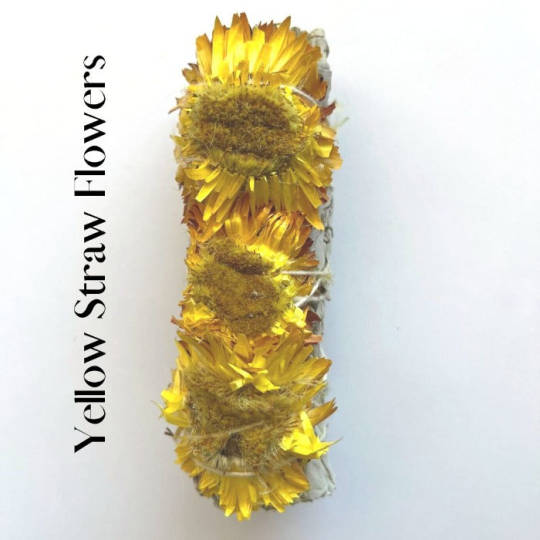
Thrilled to introduce our latest creation: Yellow Straw Flowers and White Sage Smudge Sticks! 🌿✨
🌼 Yellow Straw Flowers: Known for their sunny disposition, these flowers add a burst of positive energy to your smudging ritual. Embrace their uplifting vibes and let them bring joy to your surroundings.
🌿 White Sage: Revered for centuries for its cleansing properties, white sage is the perfect companion to the straw flowers. Let its aromatic essence purify the air and create a serene atmosphere.
Whether you're a seasoned smudging enthusiast or new to the practice, our Yellow Straw Flowers and White Sage Smudge Sticks offer a delightful and effective way to clear away negative energy and invite tranquility into your life.
Perfect for: ✨ Home Cleansing Rituals ✨ Meditation Spaces ✨ Relaxation and Stress Relief
Each smudge stick is carefully handcrafted to ensure the highest quality. Our commitment to sustainability means that these bundles are harvested responsibly, giving you a guilt-free way to connect with nature.
Ready to elevate your smudging experience? DM us to place your order or visit [https://www.etsy.com/shop/nexcube] for more details. 🌿🌼
#SmudgeSticks#NaturalCleansing#YellowStrawFlowers#WhiteSage#WellnessJourney#Handcrafted#Sustainability#Relaxation#PositiveEnergy ✨
2 notes
·
View notes
Text
A New Neighborhood
I keep seeing posts about Decades Challenges and Test of Time Challenges that made me want to try something similar again. I gave in and started a new neighborhood, but I have been hesitant to share about it because the last time I tried something similar, it fell apart and I abandoned it as soon as I posted.
But this time it has gone very well and I have made a lot of progress. Be warned that I may abandon this at any time. I will eventually get back to my kingdom neighborhood. I have already played through most of the merchant class and I have a couple of posts started in my drafts from almost a month ago.
So, as usual, I started out with 8 sims, 4 men and 4 women with a mix of genetics, random names, aspirations and personalities and moved them into an empty lot. I set them up with the bare essentials (empty fridge, a couple of counters, straw beds, tree stump chairs, squat anywhere spots and waterfall showers.) Then I filled up the lot with trees that can be chopped, harvestable berry bushes and fruit trees. They got a fishing pond, garden plots, and all sorts of crafting stations. I’m not using the in game money system at this point, so I use motherlode anytime they need more funds. Also the visitor controller blocks all NPCs, so I don’t have to bother with bills.

They were off to a good start, with everyone getting along well.

Aside from some inevitable cheating and jealousy, but fortunately, no one holds a grudge over it for long.
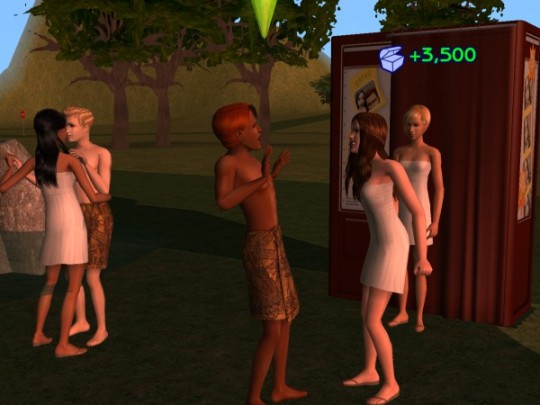
At the start there wasn’t much interest in gardening or fishing, but with the fruit trees and berry bushes that I edited to be harvested autonomously based on hunger, they were well stocked with food. (It doesn’t mean they were always smart enough to fix something to eat before they were near starving.)

Or that they were successful at cooking when they tried.
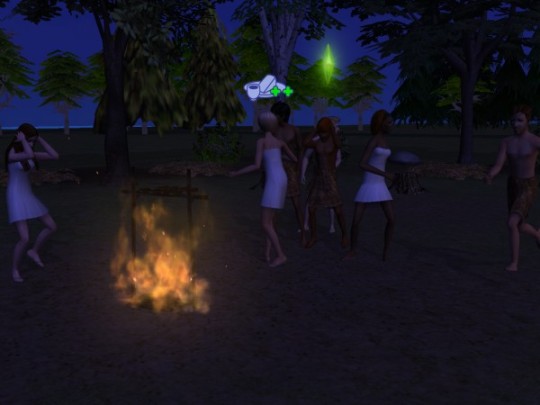
They chopped enough wood that they were able to build shelter before winter. I trade one stack of wood per wall section or floor tile to build a roof.
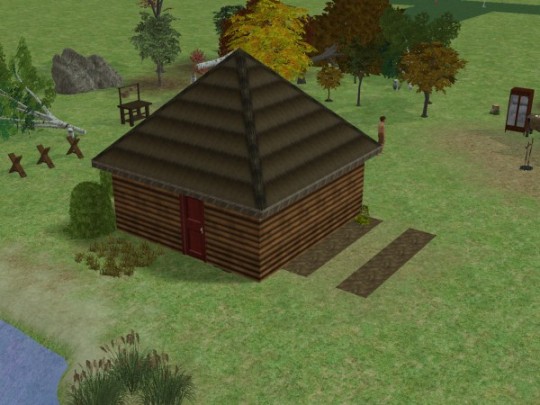
This first room is the nursery to separate the crying babies from the sleeping adults.

They had enough wood to build two more rooms for adult sleeping quarters (minus part of the roof on the third room) before winter.

Things were going well, except for the fact that just one man was the father of most of the children in the camp and another one of the men had no children at all. I knew that was going to pose a problem in the next generation or two, so I decided I needed to add another family. I decided to wait to see if they survived the winter first, since that’s where I gave up last time, but the winter was mild. There was only one incident of freezing and he survived, so I decided to start a second camp.
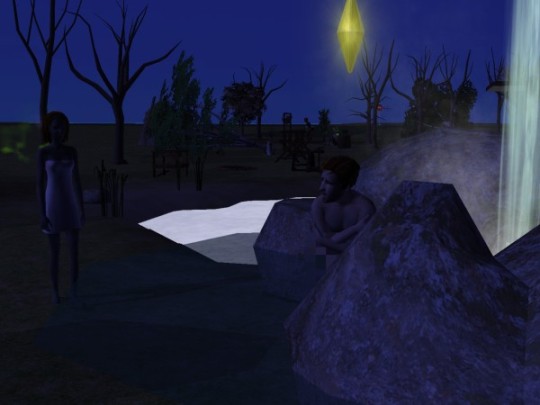
The second family was a total disaster.
They did not seem to like each other from the start.
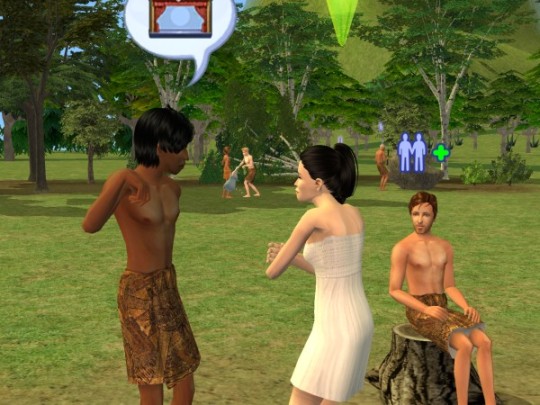
Those that did were same sex couples, which is fine, but not helpful to my population problem.
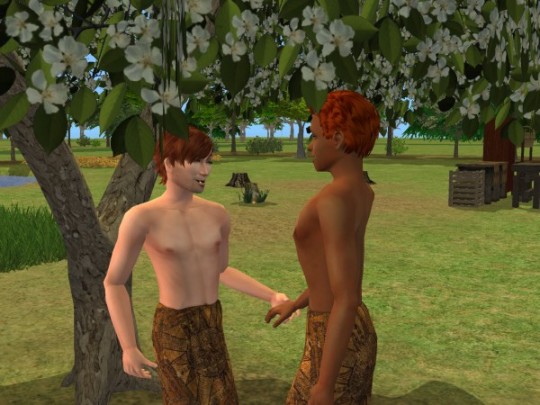
When sims from my first camp would visit, they would wreck their relationships.

It turns out I didn’t have the empty templates installed and I forgot to clear out the neighborhood before starting, so I have all the Peasantview townies.
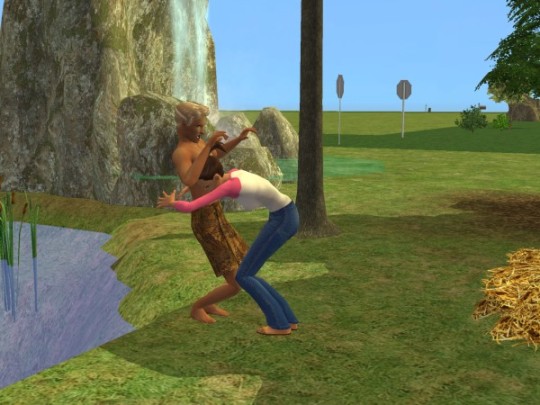
I blocked them from my first camp, but decided to let them in the second. That introduced roaches and the flu to the neighborhood.

A blind date from one of the townies did lead to love for one of my sims. Unfortunately, she died young and I can’t find a picture of what happened.
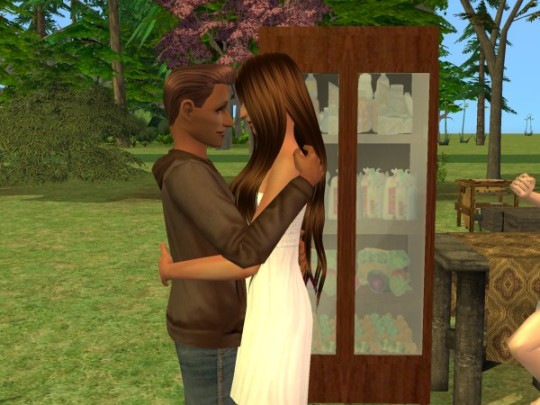
I decided to separate the group and see if the less troublesome sims from this camp would do better on their own.

They were just two happy couples.

These two (Rex and Tomas) would autonomously get engaged, then break off the engagement, every other day.
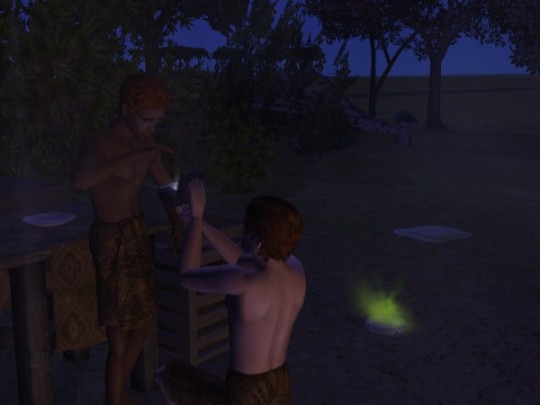
This group . . . just as soon as I would start to like a couple, one of the pair would die. Ultimately, they did introduce a little bit of new blood to the neighborhood, but not as much as I would have hoped. I’m still adding in new sims as potential partners. I’m trying to do better at making them matches for the sims that I already have rather than just random sims.
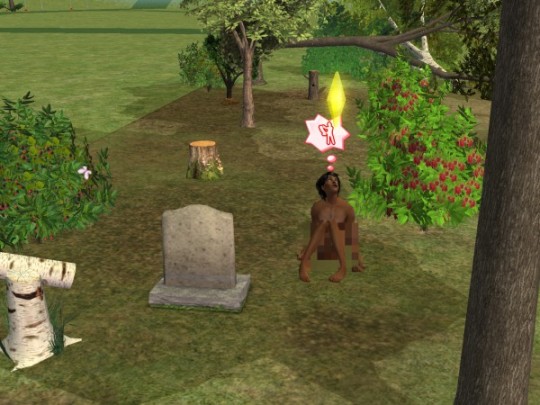
Here are the sims I started with in my original Alpha camp. (In alphabetical order, because that’s how they were listed on my screen.)
Anthony was the only sim who could not find love among the original camp members, which is unfortunate since he was a family sim and wanted nothing more than to fall in love, get married, and have a baby. I had to add in a third group of sims before he found the love of his life and started a family. In the meantime he was the camp lumberjack and was one of the first to get into chopping trees and processing boards.
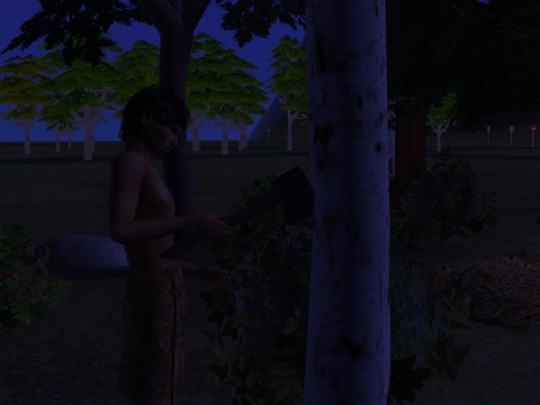
Dinah was interested in nature. It took until the second year for anyone to want to plant crops or fish, but once she started to take an interest, she consistently wanted to plant more crops everyday.
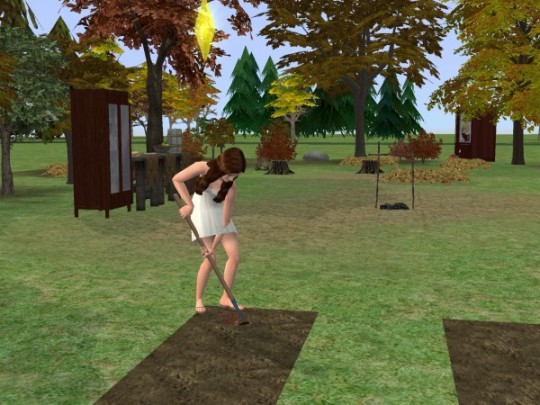
She was also into hiking and once or twice in her later years, she took a group of children who were interested out on an excursion.
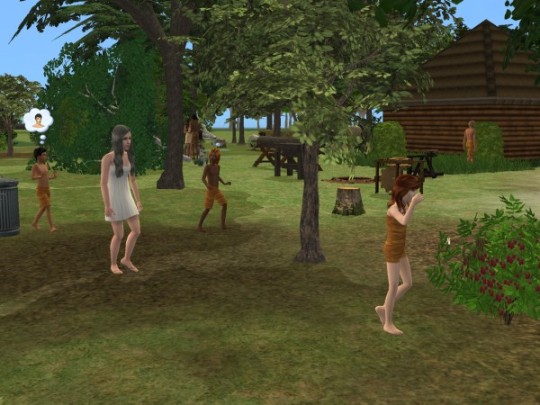
Doug was the other garden enthusiast in the first generation and he eventually took up woodworking too. He only had one child of his own, but he was very active with helping out with the other little ones in the camp.

Fernando was the camp Casanova. He had romances with three out of four of the women in the camp. At one point all three of them were simultaneously pregnant with his children. He ended up fathering ten children in total. At the time 2/3 to 70% of the children were his.
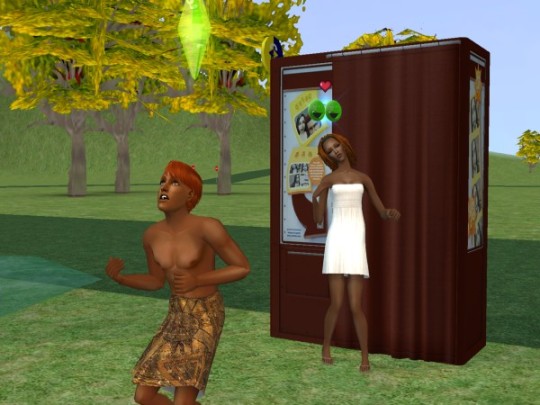
Having that many children eventually took its toll on his romance sim aspiration.

Magda was the only woman in the camp who did not fall to Fernando’s charms.

Magda had a difficult time. Her pleasure sims needs weren’t being adequately met and she started spending time in aspiration failure.

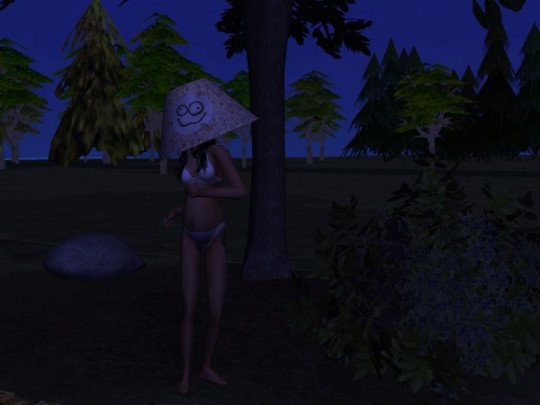
She was also the first sim in the camp to die. Dinah had a close call previously and I decided to intervene because she was pregnant with her first child. I tried to intervene with Magda too, but with the bed in the way, I couldn’t get anyone to her in time.

Misha is a sim that kind of fell under the radar. She was just a solid, low drama sim, who kept her head down and did her thing. She was the last of the women in the camp to have a baby.
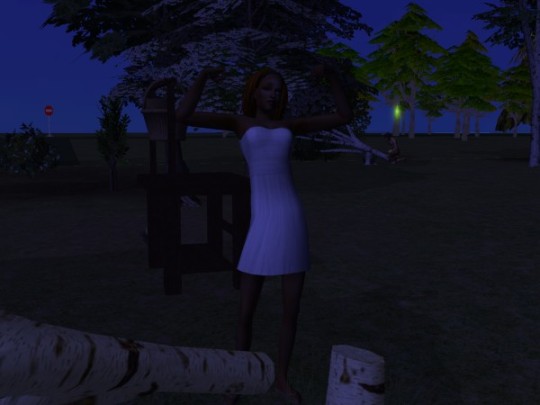
Rosalyn was the first sim in the camp to give birth to a baby. She was a very devoted mother with her first child and was constantly nursing the baby.
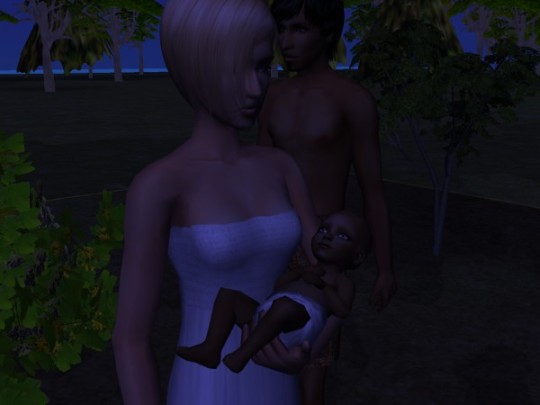
After giving birth, she immediately wanted to make a wish on the genie lamp that I hadn’t realized was on the lot. I decided that she earned it.
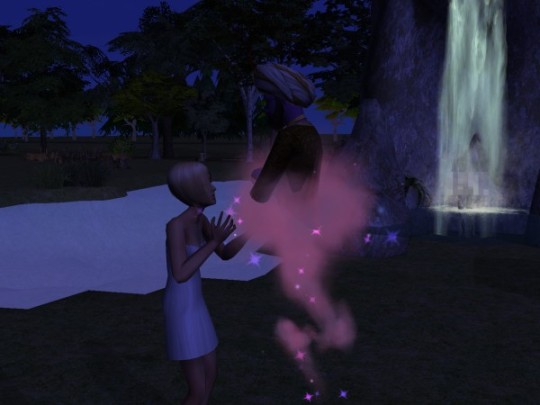
Wishing for the power to cheat death, definitely paid off.
(I think Doug ended up taking the last two wishes and used them for beauty. Can a sim make the same wish twice? It didn’t do him any good.)

Being a mother was fun the first time around, but by the fourth time, it was a bit too much.

Theron is another sim that I don’t have a lot to say about. He was the first one to get engaged when he spontaneously proposed to Dinah.
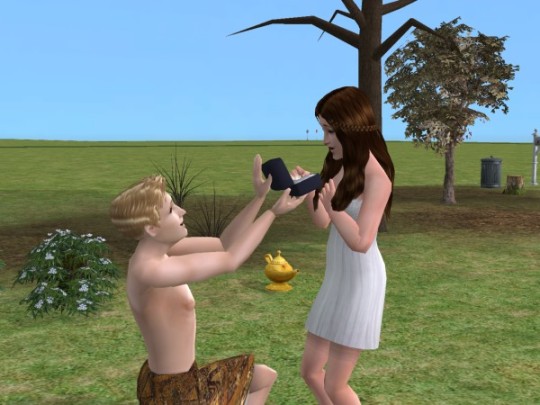
And he was the first to call of the engagement after catching her cheating with Fernando while at the neighbors’.

He was very sweet to comfort Dinah’s children (and Fernando’s not his) after the breakup to let them know everything was okay and nothing would change because of the breakup.
He also turned out to be the sim that proved to me that I was smart to disable teen-adult relationships when he was an elder and the second generation was reaching adulthood
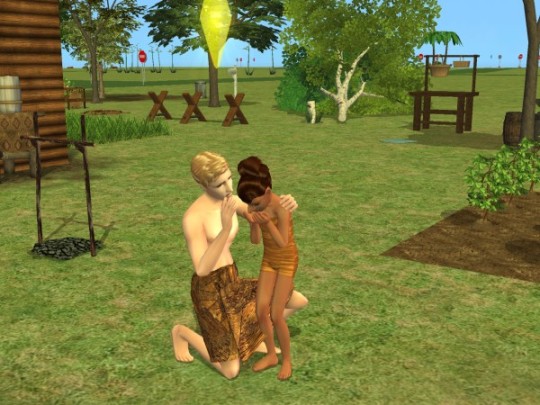
3 notes
·
View notes
Text
The whole "dangerous to wield a scythe while wearing a skirt" isn't completely inaccurate...BUT...!
The danger of the skirt comes from the handles catching in the folds of the skirt.
You know what else it can catch on? The fabric of one's pants. Hell, even hose, form-fitted to the leg, can catch on a tool handle if you're swinging it around your body in a scything arc.
BUT...!
A properly fitted scythe, one matched to your height, allows it to swing outward from your body while keeping the blade down at ground level, just skimming off that ground. The movement is like twisting back and forth and letting your arms fling out and flop back, only a little bit more controlled.
If the scythe was built for someone else, height-wise, this motion will not be perfect, and will catch the handles on your clothes.
People working in the fields at haying and harvesting times are using whatever scythes are on hand...most of which would have been crafted for someone else to wield. It's going to be just different enough that you'll fumble occasionally, especially at the start when you're just getting used to it.
The motion of using a scythe does not involve twisting the lower body enough to make a skirt flare outward all that much. And if you're wielding a scythe meant for you, then that is taken into account. And if you're wearing clothes you made to work in, the fabric isn't going to flare out that much anyway. The fancy skirt with lots of yards of fabric, which took literal months to spin and weave, will be left at home and only be worn on non-hard-labor days.
Certainly, you're not going to wear a floor-length skirt in the fields! You're going to wear something calf-length, so that it doesn't catch on all the stubble from the straw or hay or whatever being cut, and it's going to have just enough flare to allow you to move. Or in some cultures, a slit up one or both sides. Or you're just going to gird your loins, which means pushing it through your legs, bringing it back around to the front on each side, and then knotting the hemlines at hip-height so that you can move more freely.
...Trousers being developed by cold-climate people as a means of keeping warm, not as a means of protecting against horseback riding, is 100% legitimate. Let me add an extra explanation as to why:
A lot of far-northern countries (such as Iceland and Finland) have separate duvets or bedding for husbands & wives. Even though they're sharing the same bed, they have their own bedding.
Why, you may ask?
Drafts.
If you have ever shared bedding with someone on a cold night, if you roll or shift away, that lifts up the blankets draped down between you, and that sucks in a lot of cold air. it is annoying if you're in a heated home...but can be life-threatening if you are not, as it rapidly depletes your body heat, and eats up even more of the calories used to make that heat. And when it's freezing out, you gotta conserve heat and calories.
That, and it spares both partners from having their blankets stolen by their other partner as they sleep. Plus, you can still canoodle with two sets of bedding, but you literally avoid the dangers of trying to share one set of bedding in sub-arctic/-alpine to arctic/alpine conditions. Besides, you can always share a top layer blanket, too!
Skirts and trousers work like that. Skirts trap air about as much as trousers do, but when you combine the two, it's even better. The best part about wearing skirts is that it's easier to cool off if you get overheated; just flap the skirts, and it acts like shifting in bed while sharing blankets with someone else. Cool or cold air comes rushing in as the space/volume inside the skirt area gets altered...except it only affects you, and not anybody else.
I will say that it is easier to move through deep snow in trousers than in skirts. There's no deying that! But you can rise above the deep snow on skis or snowshoes (just make sure the total surface area is big enough to support your weight), and it stops being such a problem.
Adjusting what you wear & the tools you use (snowshoes, properly fitted scythe handles, etc) will affect the performance you can give, but that's about it.
(It is also easier to swim in trousers than in skirts, but that's more a factor of having that much more fabric for the water to drag at, than anything else. And at that point, wind can snag your clothes, whether it's a cloak or a skirt, and start to push you around, if it's strong enough.)
There are plusses and minuses for everything, folks! It's just that sometimes the plusses and minuses are not due to what you're currently thinking.
Feminist fantasy is funny sometimes in how much it wants to shit on femininity for no goddamned reason. Like the whole “skirts are tools of the patriarchy made to cripple women into immobility, breeches are much better” thing.
(Let’s get it straight: Most societies over history have defaulted to skirts for everyone because you don’t have to take anything off to relieve yourself, you just have to squat down or lift your skirts and go. The main advantage of bifurcated garments is they make it easier to ride horses. But Western men wear pants so women wearing pants has become ~the universal symbol of gender equality~)
The book I’m reading literally just had its medievalesque heroine declare that peasant women wear breeches to work in the field because “You can’t swing a scythe in a skirt!”
Hm yes story checks out
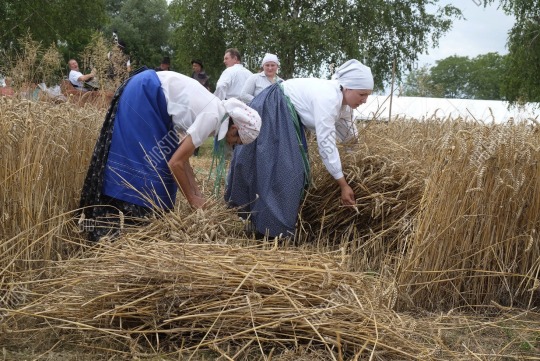
peasant women definitely never did farm labour in skirts
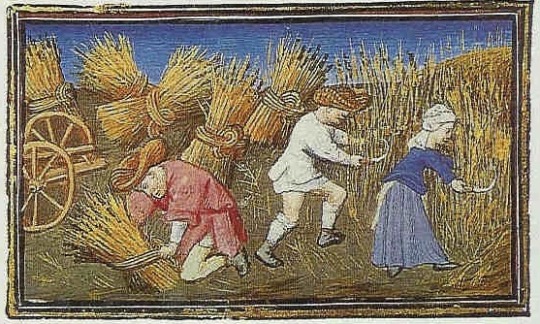
skirts definitely mean you’re weak and fragile and can’t accomplish anything
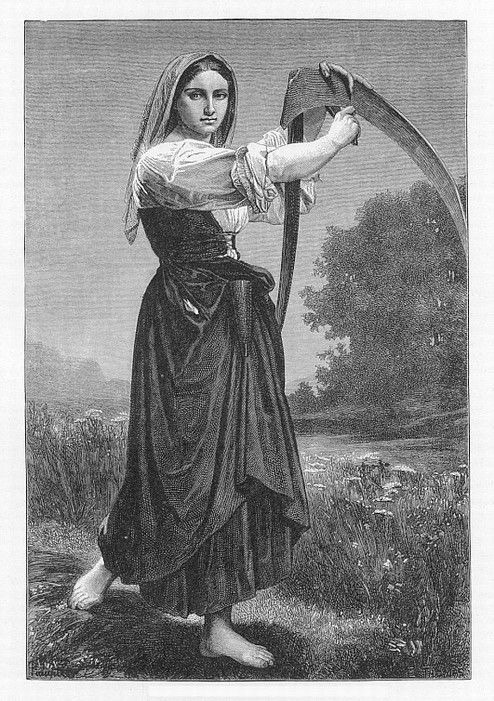
skirts are definitely bad and will keep you from truly living life
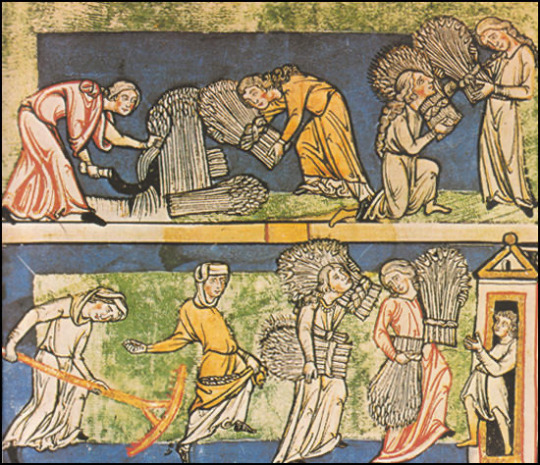
no skirts for anyone, that’s definitely the moral of the story here
96K notes
·
View notes
Text
10 Top Gardening Tips for Beginners
Never gardened before? No problem. Make your grow-you-own dreams a reality with these 10 easy-to-follow tips.
1. Site it right.
Starting a garden is just like real estate it's all about location. Place your garden in a part of your yard where you'll see it regularly (out of sight, out of mind definitely applies to gardening). That way, you'll be much more likely to spend time in it.
2. Follow the sun.
Misjudging sunlight is a common pitfall when you're first learning to garden. Pay attention to how sunlight plays through your yard before choosing a spot for your garden. Most edible plants, including many vegetables, herbs, and fruits, need at least 6 hours of sun in order to thrive.
3. Stay close to water.
One of the best gardening tips you'll ever get is to plan your new garden near a water source. Make sure you can run a hose to your garden site, so you don't have to lug water to it each time your plants get thirsty. The best way to tell if plants need watering is to push a finger an inch down into the soil (that's about one knuckle deep). If it's dry, it's time to water.
4. Start with great soil.
When starting a garden, one of the top pieces of advice is to invest in soil that is nutrient-rich and well-drained. Achieve this just-right blend by mixing 3 inches of Miracle-Gro® All Purpose Garden Soil into the top 6 to 8 inches of existing soil if you're planning to plant in the ground. If you're planting in a raised bed, use Miracle-Gro® Raised Bed Soil, which is the perfect weight and texture for raised bed growing.
5. Consider containers.
When space is at a premium, look to containers. You can grow many plants in pots, including vegetables, herbs, flowers, fruit trees, berries, and shrubs. When gardening in containers, use a pot that's large enough for the plant it's hosting, and fill it with Miracle-Gro® Moisture Control® Potting Mix. Not only is it specially formulated to help plants in pots thrive, but it also helps protect against over- and under-watering.
6. Choose the right plants.
It's important to select plants that match your growing conditions. This means putting sun-loving plants into a sunny spot, choosing heat-tolerant plants in warm climates, and giving ground-gobbling vines like pumpkins and melons ample elbow room (or a trellis to climb). Do your homework and pick varieties that will grow well where you live and in the space you have. And to get a step up on success when growing veggies and herbs, start with vigorous young plants from Bonnie Plants® instead of trying to grow from seed.
7. Discover your zone.
Knowing your "hardiness zone" can help you choose the best plants. Simply put, it describes the coldest place a plant can grow. The higher the zone number, the warmer the climate. So if a plant is "hardy to zone 4" and you garden in zone 5, that plant will survive in your yard. If, however, you're in zone 3, it's too cold to grow that particular plant. Find out your hardiness zone.
8. Learn your frost dates.
Planting too early (or late) in the season can spell disaster for your garden. You need to know the last average spring frost date for your area so you don't accidentally kill plants by putting them out prematurely. It's also good to know your first average fall frost date so that you get your plants harvested or moved indoors before late-season cold damages them. Discover the average first and last frost dates for your area.
9. Add some mulch.
Apply a layer of mulch that's 2 to 3 inches deep around each plant. This will help reduce weeds by blocking out the sun, and reduce moisture loss through evaporation, so you have to water less. For a polished look, put down a layer of Scotts® bagged mulch. Or, you can put down straw, shredded leaves, pine straw, or some other locally available material.
10. Feed plants regularly.
We've already talked about the importance of starting with great soil, but that soil works best in concert with regular boosts of high-quality nutrition for your plants. In other words, amazing soil + top-notch plant food = super garden success! So, a month after planting, begin feeding your garden with plant food like Miracle-Gro® Water Soluble All Purpose Plant Food. Be sure to follow label directions.
0 notes
Text

Handicrafts of Grobsters: A Tradition of Art and Magic
Handicrafts in Grobstrov are deeply intertwined with the island’s daily life, its natural surroundings, religious rituals, and folklore. Passed down through generations, these crafts hold symbolic meaning and are often linked to local magic and cultural customs. Many items are crafted not only for decorative purposes but also to protect against evil spirits, strengthen connections with ancestors, and uphold age-old traditions.
1. Weaving Protective Mats and Amulets
Skilled artisans weave mats and fabric amulets that are hung in homes, on doors, and windows to protect residents from evil spirits. These mats are adorned with symbols connected to the Peterean faith and the native magic of Grobstrov, featuring spirals, stars, and botanical patterns. Placed in homes, churches, and even public buildings for protection, smaller amulets are also carried for personal "curse prevention."
2. Woodcarving and Amulet Crafting
Carving wooden amulets and figures is a cherished tradition on the island. Many amulets are crafted from wood collected in the Forbidden Forest, lending them unique mystical power. Common motifs include spirits, animals, and symbols believed to bring luck and protection from harm. These amulets are hung on trees, gravesites, in homes, and workplaces to protect workers and bless harvests.
3. Candle and Holder Making with Magical Symbols
Candle-making on Grobstrov has deep religious and ritual significance. Made from natural beeswax and local herbs, candles often contain extracts from plants found in the Forbidden Forest. Candle holders are crafted from wood or stone and adorned with magical symbols. Lit during prayers, rituals, and ceremonies to honor ancestors and connect with the Watcher and spirits.
4. Wreath and Herb Amulet Weaving
Weaving wreaths and herb amulets is both a popular craft and a form of magical practice. Wreaths often include plants like rosemary, lavender, sage, and rare island herbs. Hung over doors and windows for protection, worn as accessories for Halloween, or used in rituals related to natural cycles.
5. Making Ritual and Ceremonial Dolls
Dolls are crafted from straw, fabric, and small pieces of wood. Depending on the ritual, they may be used for protection, luck, or to ward off evil spirits. Artisans carefully select materials, ensuring each doll carries the desired properties. Used during holidays and rituals. Dolls are burned, buried, or left in the forest to repel bad luck or lift curses.
6. Crafting Herbal Sachets for Healing and Protection
Herbal sachets are made from fabric and filled with local herbs, roots, and dried flowers. These sachets are commonly used for health protection, good fortune, or as keepsakes in the home. Residents carry these sachets in their pockets, hang them under beds, or leave them in vulnerable places.
7. Embroidering Protective Symbols on Clothing
Embroidery on clothing has magical significance on Grobstrov. Men and women stitch protective patterns, symbols, and traditional designs onto collars, sleeves, and cuffs to ward off evil and attract luck. Embroidered designs are seen on daily attire, especially holiday and ritual garments.
8. Herbalism and Gathering Medicinal Blends
Local herbalists gather plants from the forests and fields, creating healing blends and mixtures for rituals. Each herb has its symbolic meaning and unique application in ceremonies. Herbal mixtures are used as tinctures, ointments, powders, and ritual additives. Sold at markets, these blends are used for healing and protection.
9. Crafting Bone and Metal Jewelry Amulets
This craft is rooted in ancient beliefs and superstitions. Bones from small animals and birds gathered in Grobstrov forests are polished and transformed into earrings, rings, and pendants. Metal elements add weight and significance, making the jewelry a powerful family relic. Bone and metal amulets are considered potent charms, protecting against evil spirits and curses.
10. Pottery and Ritual Vessel Crafting
Grobstrov artisans create pottery vessels, often shaped like skulls, for ritual use. These ceramics are slowly fired, preserving the texture and designs imprinted on them. Ritual vessels hold herbs, bones, and magical items used in ceremonies. Skull-shaped vessels symbolize ancestral memory and are placed on home altars.
These traditional crafts are more than just decorations—they’re powerful spiritual tools that help Grobstrov’ residents maintain a connection to nature, history, and the spirits of the island. Each piece is imbued with profound meaning and continues to support the unique traditions and folklore of this mystical place.
0 notes